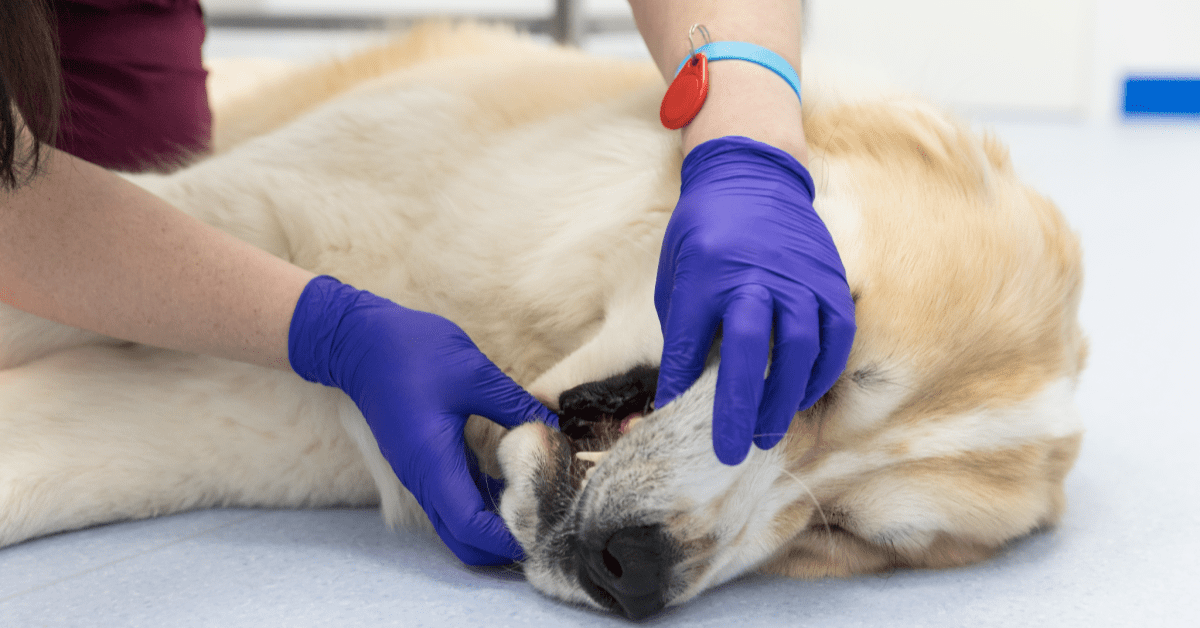Key Points
- Pale dog gums occur when there is either poor blood circulation throughout the body, or there are too few red blood cells to provide adequate oxygen to the body.
- There are a variety of underlying causes for pale dog gums including dehydration, bleeding, anemia, and chronic disease.
- Don’t hesitate to take your dog to the vet if they have pale gums, but especially if they’re displaying other concerning symptoms such as lethargy, lack of appetite, and difficulty breathing, just to name a few.
Healthy dogs typically have pink gums, but if you notice that your dog’s gums are pale or white, it could be a sign of an underlying issue. If you’re thinking to yourself, “Gee, my dog’s gums look paler than usual!” it’s worth a closer look. Here’s what you need to know.
Why are my dog’s gums pale or another color?
Healthy dogs will have pink-colored gums – any other color may indicate something is wrong. Here are some different colors that can point to an issue with your pup’s health:
- Light red gums can indicate the presence of oral issues such as gingivitis, infection, or other related problems.
- Cherry red gums can point to potential contact with toxins or other common poisons that are harmful to dogs. Cherry red gums could also be a symptom of carbon monoxide poisoning, heatstroke, or high blood pressure.
- Blue or purple gums could indicate signs of hypothermia, trouble breathing, pneumonia, heart disease, or low blood pressure.
- Yellow gums may suggest anemia, red blood cell damage, or liver issues.
- Pale or white gums could be a potential sign that your dog is experiencing anemia, shock, blood clotting disorders, internal bleeding, or heart disease.
Why are pale dog gums cause for concern?
Ellen Russell, DVM, MPH, from The Malamute Mom says, “Pale gums occur when there is either poor blood circulation throughout the body, or there are too few red blood cells to provide adequate oxygen to the body.”
“A variety of different things can cause this, including blood loss from internal bleeding or other trauma, anemia (decrease in red blood cell count) caused by chronic diseases of the heart or kidneys, or other causes of shock such as severe infection (sepsis).”
If you spot pale gums in your dog, it’s better to be safe than sorry and schedule a vet visit.
Causes of pale dog gums
In general, pale gums are an indication that your pet may be suffering from anemia. Anemia means that your pup has a shortage of red blood cells and hemoglobin in their body. These red blood cells are vital because they’re responsible for delivering oxygen to different parts of the body. So when there aren’t enough, your dog’s gums can look pale. Anemia can be caused by many conditions.
We will discuss a few of the more common causes of anemia below:
Cancer
Sometimes different types of cancer can cause tumors that bleed, and these tumors are often found in places like the spleen, liver, gastrointestinal tract, and kidneys. The thing is, these tumors can grow rapidly and get big, so they might rupture and cause a sudden, severe bleed.
Kidney disease
When your dog has severe kidney disease, they might become dehydrated because their body can’t hold onto water like it should. This dehydration in dogs can mess with circulation and cause inflammation. In addition, kidneys actually create a hormone that signals the bone marrow to produce more red blood cells, the levels of this hormone can drop dramatically with chronic kidney disease which can lead to anemia.
General bleeding
Blood loss can occur for a variety of reasons. Sometimes it’s because of an injury or trauma, other times, blood loss can happen because of a nasty parasite infestation – things like fleas and ticks or worms can all cause bleeding problems.
Blood clotting disorders
Some dogs are born with blood clotting disorders such as Von Willebrand disease or Hemophilia A, which can cause abnormal bleeding. Other conditions that can cause anemia are certain types of cancer, autoimmune diseases, as well as ingestion of specific types of rat poison.
Parasite infections
Have you ever noticed fleas or ticks on your pet? These pesky parasites feed on your dog’s blood, and if there are many of them, they can start to cause a serious problem. Severe infestations with these external parasites, as well as hookworms (which feed on blood in the intestines), can cause serious blood loss. When that happens, your pet might feel tired and weak, and their gums may look pale.
Zinc poisoning or toxicity
Zinc poisoning is when your dog eats something with a lot of zinc (a heavy metal), like coins or nails. Even though zinc is something that your dog needs in small amounts, if they get too much of it, it can be awful for them because it can interfere with how their body absorbs iron (which is essential for making red blood cells!) So if your dog gets too much zinc, they might start to feel tired and weak, or even display other symptoms like vomiting, diarrhea, or jaundice.
Internal bleeding
Sometimes bleeding can happen inside the body, referred to as internal bleeding. This can happen for various reasons such as trauma, bleeding ulcers or tumors, clotting disorders, or exposure to certain kinds of poison. When there’s internal bleeding, your pup’s body loses blood, which can cause anemia, making the gums look pale or even white.
How to determine if your dog has pale gums
First, gently lift your pup’s upper lip and lower lip to examine the color of the gums. If the gums are pink in color, they are healthy. Next, gently touch your dog’s gums to see if they feel damp. If they feel sticky instead, it could indicate that your pup is dehydrated and needs extra water.
Checking your dog’s gums monthly is a good idea to keep tabs on their overall health. If you can make it a habit to check their gums every time you brush your dog’s teeth (ideally, you’re doing it a few times a week), even better! Remember that caring for your dog’s dental health is as important as its other health needs.
It’s also a good idea to keep an eye out for any changes in your dog’s gums’ look and texture. Also, remember that if your dog has mottled or pigmented gums, it can be hard to see if they have turned pale or not by doing a capillary refill test.
What to do if your dog has pale gums
Ellen Russell, DVM, MPH, says, “If you feel like your dog’s gums are unusually pale, it is almost always a medical emergency, and you must seek veterinary care right away.”
So, suppose your dog has pale or white gums or displays any of the following symptoms in conjunction with pale gums. In that case, taking them to an emergency veterinary clinic is crucial.
These signs can quickly become life-threatening if not properly diagnosed and treated promptly.
- Loss of appetite
- Trouble walking
- Bloated stomach
- Coughing
- Weakness or drunken gait
- Collapse
- Lethargic and lack of energy
- Bruising
- Rapid breathing
- Any trauma, like if they were hit by a car
- Difficulty breathing
The bottom line on pale dog gums
Pale gums in dogs can be a concerning sign of an underlying issue, so it’s vital to take action and get to the bottom of it.
Regularly checking your dog’s gums and monitoring their overall well-being can catch any potential health problems early on and get them the care they need. If you notice pale gums or any other concerning symptoms in your dog, don’t hesitate to contact your veterinarian for advice.




